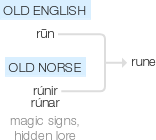Rune
Old English rūn ‘a secret, mystery’; not recorded between Middle English and the late 17th century, when it was reintroduced under the influence of Old Norse rúnir, rúnar ‘magic signs, hidden lore’.
wiktionary
Borrowed from Old Norse rún, which is from Proto-Germanic *rūnō(“letter, literature, secret”), which is borrowed either from Proto-Celtic *rūnā or from the same source as it; compare Dutch rune, German Rune and Swedish runa. Compare roun.
etymonline
rune (n.)
a modern book-form to represent Old English run, rune "secret, mystery, dark mysterious statement, (secret) council," also "a runic letter" (runstæf), from Proto-Germanic *runo (source also of Old Norse run "a secret, magic sign, runic character," Old High German runa "a secret conversation, whisper," Gothic runa), from PIE *ru-no-, source of technical terms of magic in Germanic and Celtic (source also of Gaelic run "a secret, mystery, craft, deceit, purpose, intention, desire," Welsh rhin "a secret, charm, virtue"). Also see Runnymede.
The word entered Middle English as roun and by normal evolution would have become Modern English *rown, but it died out mid-15c. when the use of runes did. The modern usage is from late 17c., from German philologists who had reintroduced the word in their writings from a Scandinavian source (such as Danish rune, from Old Norse run).
The presumption often is that the magical sense was the original one in the word and the use of runes as letters was secondary to ancient Germanic peoples, but this is questioned by some linguists. The runic alphabet itself is believed to have developed by 2c. C.E. from contact with Greek writing, with the letters modified to be more easily cut into wood or stone. Related: Runed; runecraft.
